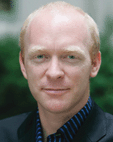DOI:
10.1039/C2CC90080G
(Profile)
Chem. Commun., 2012,
48, 5064-5064
Interview with Amar Flood
 | | | Plate1 | |
|
Do you remember what it felt like to publish your first ChemComm article?
The first ChemComm article I published was also my first one as an independent researcher at Indiana University (Chem. Commun., 2007, 2692–2694, DOI: 10.1039/B703301J). For this reason, it will always be special. At the time, I remember it felt great to out of the blocks and a relief not to get scooped.
How has your research evolved from your first to your most recent article?
Interestingly, that first article was on metal binding into the ligand environment created by triazole nitrogen donors. I reasoned, at the time, that the coordination chemistry of cations was well developed. Consequently, I sought to learn as much as I could about the new ligand we had created. A key attribute was that triazoles were sterically small, which opened up the freedom to construct compounds where the triazole could be a useful linker. The first molecule we considered led to the watershed of work on triazolophanes and the discovery that the triazoles have activated C–H donors capable of competent hydrogen bonding. In other words, that first paper helped us to redirect our efforts towards anion recognition.
While the research evolved, one common thread always runs through our work; and that is to ask the question, what are the molecules trying to tell us? This approach gives one the freedom, not only to execute hypothesis-driven research agendas, but to look beyond the immediate results that fulfil expectations. Answering this question, by looking both deeper and wider at the unexpected, can make all the difference in opening up novel lines of research.
What do you like most about publishing in ChemComm?
I like the promptness of ChemComm, its no-nonsense format and free color graphics.
What aspect of your research are you most excited about at the moment?
Having developed a lot of the fundamental science relating to the anion recognition that is possible with triazoles and triazolophanes, it is now time to consider ways to take it further along the path towards applications. While such lofty goals are years away, the first steps are best taken by us, the folks who can see these futures and who can help realize the proof-of-principle experiments that are needed. In particular, we want to focus on chloride in biology because it is one of the most abundant anions and because triazolophanes have a high selectivity for them.
What is the best part of your job?
The creative freedom to imagine something new, realize it in a molecular format and then test its performance against those formative ideas.
What is the secret to success in scientific publishing?
Write for your target audience and consider it akin to fine dining; ensure the reader understands and enjoys every moment of their experience.
What is your advice to young emerging scientists?
Develop a system (molecule, technique etc.) that will enable you to be both creative and productive. For us it was to make triazolophanes and help popularize triazoles as easy-to-install hydrogen bond donors.
What do you do in your spare time?
Spend time with my family.
By the time I’m 100 I would like to have……
....made a lasting impression on the development of science through the people I have helped to train and inspire.
|
| This journal is © The Royal Society of Chemistry 2012 |
Click here to see how this site uses Cookies. View our privacy policy here. 
